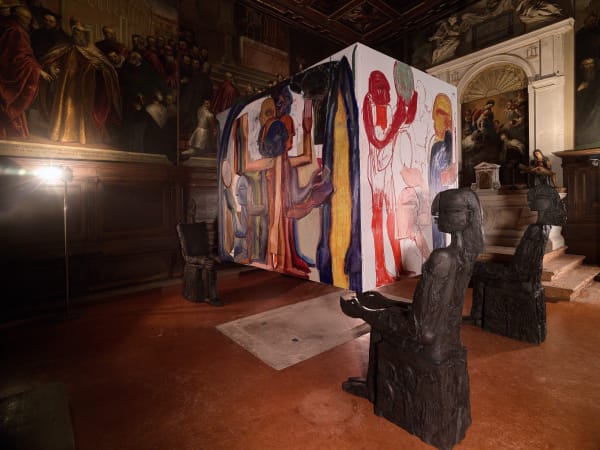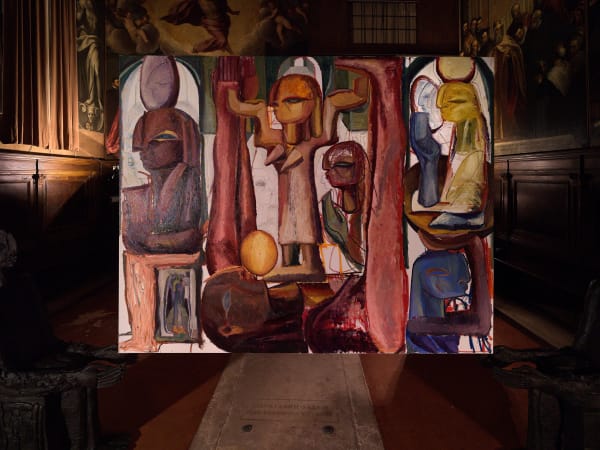Where the Sun Sleeps is an evocative installation by Romanian artist Tincuța Marin unfolding in the historic Oratorio dei Crociferi alongside Palma il Giovane's most significant Renaissance cycle of paintings. Chronicling the Crociferi Order's evolution from its 12th-century beginnings in support of the Crusades to its liturgical and charitable transformation, these works provide a profound context for Marin's exploration. Executed between 1583 and 1592, Palma's cycle is one of the few singular artistic achievements of sixteenth-century Venetian art, rivalling Tintoretto's work for the Scuola Grande di San Rocco. Within this space, where history meets spiritual contemplation, and art gazes upon art, Marin's installation emerges powerfully, weaving together historical layers and diverse artistic styles.
The centre of the Oratorio is enclosed by four large-scale canvases forming a quadrangle supported by four bronze figures - Marin's installation creates an inaccessible, inviolate space within the sacred space. The sculptures' hieratic stance and elongated limbs hark back to an era of ancient mystique, reminiscent of the protective deities that once guarded old sanctuaries, invoking an uncanny reverence. They recall the function of caryatids standing as silent guardians of time. The paintings are a complex layering of forms and figures depicted in profile, some distinct and others blurred or overlapping, creating a sense of depth and multiplicity.
Like an alchemist, Marin appropriates and amalgamates different visual signals from the Egyptian practice of portraying pharaohs and gods, in which modernist still-life decompositions converge. The artist is fascinated by Nut, the goddess of the sky, stars, cosmos, mothers, astronomy, and the universe. The symbolic arching of Nut over the earth, a powerful gesture embodying renewal and protection, resonates throughout Marin's pieces. Geometric shapes and the interplay of light and dark within the compositions recall both - the narrative depth of Roman frescoes and the cosmic symbolism in Egyptian temples. It suggests the palimpsestic nature of ancient walls, where new stories were inscribed over old. The way colours cascade and blend across the forms brings to mind the frescoes of Pompeii, where images would emerge vibrantly against plaster. The use of blues and reds recalls the lapis lazuli and carnelian frequently found in ancient Egyptian art. Marin wields hues and different pictorial styles with the precision of a composer, using them to invoke moods, suggest fragments of ancient beliefs, or fuse the metaphysical into the tangible. It uncannily resonates with the grandeur of Palma il Giovane's compositions and the spiritual reverence of the space.
Where the Sun Sleeps arises on the threshold of the past and present, set against the Oratorio's historical backdrop. Tincuța Marin crafts an anachronistic collage of time, akin to a "wunderkammer" filled with eclectic temporal artefacts repurposed for new narratives. Egyptian deities, medieval and modernist references are not employed for their symbolic weight but as elements in a grander pictorial lexicon that dances on the verge of phantasmagoria.
The exhibition is made in collaboration with Triade Foundation, Stephenson Art and Ellen de Bruijne Projects, with an introductory note by Adina Drinceanu.







